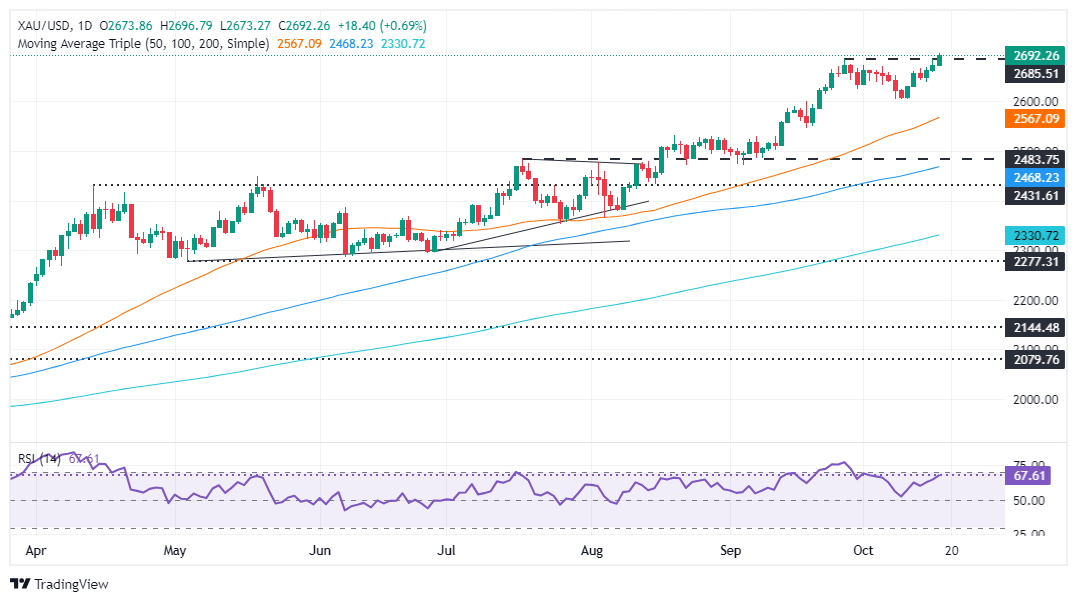Gold surges to record high near $2,700 amid high US yields, good US data
- Gold surges to $2,691, boosted by uncertainty surrounding US elections, despite robust Retail Sales and job data.
- US 10-year Treasury yield rebounds to 4.096%, capping Gold’s advance as the US Dollar Index reaches a two-month high.
- Traders trim bets on a Fed rate cut, with odds for a November 25 bps reduction dropping to 88.2%.
Gold price hit a record high during the North American session on Thursday, yet it failed to hit $2,700 amid uncertainty around US elections. Data-wise, the US economy remains resilient following Retail Sales and jobs data, though it didn’t weigh on the precious metal. At the time of writing, the XAU/USD trades at $2,691, up by over 0.66%.
The US Department of Commerce revealed that Retail Sales rose slightly above estimates. At the same time, the US Labor Department revealed data on fewer Initial Jobless Claims, which weighed on Bullion prices.
After the data, the US 10-year Treasury yield rebounded off its lows, rising eight basis points to 4.096%. The Gold price dipped to $2,672 but has recovered some ground, shrugging off broad US Dollar strength.
The US Dollar Index (DXY), which tracks the Greenback’s currency against a basket of six peers, rose over 0.26% to 103.79, a nearly two-month peak.
Following the data, the Atlanta Fed GDP Now estimates the US Gross Domestic Product (GDP) to grow 3.4% from 3.2% on October 9.
Given the backdrop, traders trimmed their bets on the Federal Reserve’s (Fed) easing in the final two Fed meetings of the year. For the upcoming November meeting, the odds for a 25 bps rate cut decreased from 94% to 88.2%; while the chances of the Fed standing pat are at 11.8%.
"On top of the concerns in the Middle East, you are also nearing the US election, which is looking like a very closely contested election. And that generates a whole host of uncertainty, and Gold often is the place to go in times of uncertainty,” said Niteh Shah, a strategist at WisdomTree.
Daily digest market movers: Gold price climbs as investors eye key US data
- US Retail Sales for September rose by 0.4% (MoM), exceeding estimates of 0.3% and higher than August's 0.1% increase.
- Initial Jobless Claims for the week ending October 12 came in at 241K, below estimates and down from last week's 258K.
- US Industrial Production contracted by -0.3% MoM in September, reversing from 0.3% growth, impacted by external factors.
- Data from the Chicago Board of Trade, based on the December fed funds rate futures contract, indicates that investors estimate 48 basis points of Fed easing by the end of the year.
XAU/USD technical outlook: Gold price surges above $2,690, eyes on $2,700
Gold’s upward bias is intact. Bulls could push the XAU/USD spot price toward the psychological $2,700 figure in the short term as the Relative Strength Index (RSI) suggests buyers are gathering steam.
Gold’s first resistance is the YTD high at $2,696. Once cleared, a move to $2,700 is on the cards, followed by $2,750 and $2,800.
Conversely, if XAU/USD falls below the October 4 high at $2,670, a retracement toward $2,650 is on the cards. On further weakness, the next support would be $2,600, followed by the 50-day Simple Moving Average (SMA) at $2,561.

Gold FAQs
Gold has played a key role in human’s history as it has been widely used as a store of value and medium of exchange. Currently, apart from its shine and usage for jewelry, the precious metal is widely seen as a safe-haven asset, meaning that it is considered a good investment during turbulent times. Gold is also widely seen as a hedge against inflation and against depreciating currencies as it doesn’t rely on any specific issuer or government.
Central banks are the biggest Gold holders. In their aim to support their currencies in turbulent times, central banks tend to diversify their reserves and buy Gold to improve the perceived strength of the economy and the currency. High Gold reserves can be a source of trust for a country’s solvency. Central banks added 1,136 tonnes of Gold worth around $70 billion to their reserves in 2022, according to data from the World Gold Council. This is the highest yearly purchase since records began. Central banks from emerging economies such as China, India and Turkey are quickly increasing their Gold reserves.
Gold has an inverse correlation with the US Dollar and US Treasuries, which are both major reserve and safe-haven assets. When the Dollar depreciates, Gold tends to rise, enabling investors and central banks to diversify their assets in turbulent times. Gold is also inversely correlated with risk assets. A rally in the stock market tends to weaken Gold price, while sell-offs in riskier markets tend to favor the precious metal.
The price can move due to a wide range of factors. Geopolitical instability or fears of a deep recession can quickly make Gold price escalate due to its safe-haven status. As a yield-less asset, Gold tends to rise with lower interest rates, while higher cost of money usually weighs down on the yellow metal. Still, most moves depend on how the US Dollar (USD) behaves as the asset is priced in dollars (XAU/USD). A strong Dollar tends to keep the price of Gold controlled, whereas a weaker Dollar is likely to push Gold prices up.